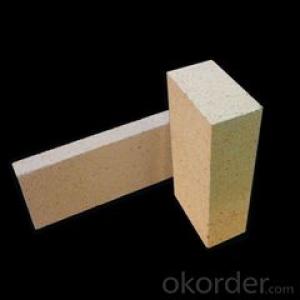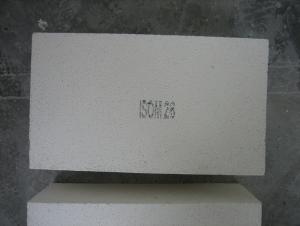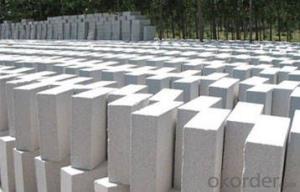Insulating Fire Brick - Refractory Mullite Insulating Refractory Brick JM 27
- Loading Port:
- Shanghai
- Payment Terms:
- TT OR LC
- Min Order Qty:
- 20 m.t.
- Supply Capability:
- 20 m.t./month
OKorder Service Pledge
OKorder Financial Service
You Might Also Like
General Information
CMAX insulating firebricks are classified under temperature between 1300℃ to 1700℃, manufactured from high purity alumina clay.
1. Lower content of iron, alkaline and impurities, good high temperature properties.
2. Homogeneous structure, light weight, energy saving because lower heat storage in the furnace during cooling cycles.
3. High strength, good thermal shock resistance under high temperature.
4. Precise sizes due to grinding and shaping after sintering, which meets the requirement of construction.
5. Max service temp: Up to 1730C (3160F)
Feature
Light weight and low thermal conductivity
Low heat storage
Low iron and impurities
High thermal shock resistance
Application of Insulating brick
Metallurgical Industry: blast furnace, hot blast furnace, heating furnace, etc..
Petrochemical Industry: ethylene cracking furnace, hydrogen furnace, the main furnace, heating furnace, etc..
Ceramic industry: roller kiln, kiln, etc..
Glass industry: glass furnace regenerator, etc.
Carbon industry: carbon furnace, etc..
Aluminum electrolysis industry: aluminum reduction cell, etc.
Other industries: tunnel kiln, shuttle kiln, etc.
Advantages of heat insulation brick
Low thermal conductivity: many air holes will bring good thermal insulation effect, energy saving.
High crushing strength: high crushing strength, volume stability.
Low heat storage: small heat storage, absorb more heat, energy-saving effect is obvious.
Technical Data
ITEM | GJM30 | GJM28 | GJM26 | GJM23 |
Classification Temperature, ℉/℃ | 3000/1650 | 2800/1540 | 2600/1430 | 2300/1260 |
Bulk Density,g/cm³ | ≤1.0 | ≤0.9 | ≤0.8 | ≥0.5 |
Reheating Linear Change, % | ≤0.9 (1550℃,12 h) | ≤0.8 (1510℃,12 h) | ≤0.7 (1410℃,12 h) | ≤0.5 (1230℃,12 h) |
Al2O3 Content, % | ≥75 | ≥65 | ≥55 | ≥45 |
Fe2O3 Content, % | ≤0.5 | ≤0.6 | ≤0.7 | ≤1.0 |
Thermal Conductivity: | ||||
800℃, w/m.k | ≤0.39 | ≤0.37 | ≤0.35 | ≤0.18 |
1000℃, w/m.k | ≤0.43 | ≤0.41 | ≤0.39 | ≤0.20 |
1200℃, w/m.k | ≤0.48 | ≤0.46 | ≤0.43 | --- |
Insulating brick


Common problem solution
1. What products do you have?
We have all kinds of refractory bricks, refractory casting materials, mortar, cement, ceramic fiber products, etc..
Or you can browse our products to choose what you need.
2. How to control product quality?
With strict quality control system throughout the material selection and production process, we have the quality of refractory materials and ceramic fiber products to meet customer requirements.
From the selection of raw materials, the quality of our control to start. The quality of the raw materials required for each batch of products in the use of the front line test. In the production process, through the quality control of workers, and then to each piece of classification, and through quality supervision and inspection.
3. Could you give me a brief introduction to the application of your product?
My Company is mainly engaged in steel, cement, glass, ceramics, petrochemical, electric power and other industries.
4. If I need you, what kind of information do you need?
In order to select the right products, we will provide us with information, such as the United States, technical data, order quantity, product applications, etc..
If you have any questions, please contact us.
- Q: Can insulating fire bricks be used in the construction of boilers?
- Indeed, the application of insulating fire bricks is possible in the construction of boilers. Comprised of lightweight materials with exceptional thermal insulation properties, these bricks prove to be apt for deployment in high-temperature scenarios, including boilers. Their utilization aids in diminishing heat dissipation and augmenting energy efficacy by impeding heat leakage from the boiler. Moreover, they exhibit remarkable resilience against thermal shock and can endure extreme temperatures, thereby establishing themselves as a dependable alternative for constructing boilers.
- Q: Can insulating fire bricks be used as insulation in walls and roofs?
- Yes, insulating fire bricks can be used as insulation in walls and roofs. Insulating fire bricks are made from lightweight materials that have excellent thermal insulation properties. They have low thermal conductivity, which means they can effectively reduce heat transfer through walls and roofs. This makes them a suitable choice for insulating buildings and improving energy efficiency. Additionally, insulating fire bricks are durable and fire-resistant, making them a safe option for insulation. However, it is important to note that insulating fire bricks are typically used in high-temperature applications such as furnaces and kilns, so they may not be the most cost-effective or practical choice for all wall and roof insulation needs. Other insulation materials designed specifically for building applications may be more suitable in terms of cost, ease of installation, and overall performance.
- Q: Are insulating fire bricks suitable for the insulation of chimneys?
- Insulating fire bricks are indeed suitable for chimney insulation. Specifically engineered to endure high temperatures and deliver efficient insulation, these bricks are perfect for chimney applications. With their elevated thermal conductivity, they retain heat effectively, thereby enhancing the chimney's efficiency by preventing heat from escaping. Moreover, insulating fire bricks possess resistance to thermal shock, enabling them to endure abrupt temperature fluctuations without experiencing cracks or breakage. This resilience is particularly vital in chimneys, where the temperature can vary significantly during the combustion process. All in all, insulating fire bricks are a dependable option for chimney insulation due to their remarkable heat retention capabilities and durability.
- Q: Can insulating fire bricks be used in the construction of flue gas ducts?
- Insulating fire bricks have the capability to be utilized in the construction of flue gas ducts. These bricks are specifically engineered to endure high temperatures and offer exceptional thermal insulation. This makes them an apt choice for lining flue gas ducts as they aid in reducing heat loss and enhancing energy efficiency. Moreover, insulating fire bricks exhibit resistance to chemical corrosion and can withstand the harmful impacts of flue gases. Nevertheless, it is crucial to guarantee that the insulating fire bricks employed are specifically designed for flue gas duct applications and fulfill the required safety and regulatory standards. Seeking advice from a professional engineer or a specialist in this field is advised to ensure the accurate selection and installation of insulating fire bricks in flue gas ducts.
- Q: Do insulating fire bricks expand and contract with temperature changes?
- Yes, insulating fire bricks do expand and contract with temperature changes. Like any material, when exposed to heat, the insulating fire bricks expand, and when cooled, they contract. This expansion and contraction occur due to the thermal expansion coefficient of the material, which determines how much it will expand or contract for a given change in temperature. It is important to consider this property when using insulating fire bricks in applications where temperature fluctuations are expected, as failure to account for the expansion and contraction may lead to structural damage or cracking.
- Q: Are insulating fire bricks resistant to phosphorus pentoxide?
- In general, insulating fire bricks lack resistance against phosphorus pentoxide. This highly reactive compound has the ability to corrode and deteriorate various materials, including insulating fire bricks. Therefore, it is crucial to contemplate alternative materials or apply protective coatings when specific applications require resistance against phosphorus pentoxide.
- Q: Can insulating fire bricks be used for insulation in power plants?
- Yes, insulating fire bricks can be used for insulation in power plants. Insulating fire bricks are designed to have excellent thermal insulation properties, which make them suitable for high-temperature applications. They can withstand extreme temperatures and provide effective insulation to prevent heat loss and increase energy efficiency in power plant operations. The insulating fire bricks are often used in various areas of power plants, such as furnaces, boilers, kilns, and chimneys. They can be used to line the walls, floors, and roofs of these structures to reduce heat transfer and maintain the desired temperatures inside the equipment. In power plants, insulating fire bricks help to minimize heat loss, improve combustion efficiency, and reduce thermal stress on the equipment. By providing a barrier against heat transfer, they help in conserving energy and reducing operational costs. Additionally, the insulation properties of these bricks also contribute to a safer working environment for power plant personnel. It's worth noting that while insulating fire bricks are suitable for insulation in power plants, they should be selected carefully based on the specific requirements and conditions of the power plant. Factors such as the operating temperature, chemical exposure, and mechanical stress should be considered to ensure the bricks can withstand the harsh conditions and provide long-lasting insulation performance.
- Q: Can insulating fire bricks be used in power plants?
- Indeed, power plants have the capability to utilize insulating fire bricks. These bricks, also referred to as refractory bricks, are specifically designed to endure extreme temperatures and offer exceptional thermal insulation. They find extensive usage in a wide range of industrial settings, including power plants. The combustion of fossil fuels or the process of nuclear fission within power plants generates a substantial amount of heat. In order to ensure efficient operations and prevent heat loss, power plants employ insulating fire bricks to line the walls, floors, and ceilings of furnaces, boilers, and other areas that experience high temperatures. Insulating fire bricks possess a low thermal conductivity, thereby effectively reducing heat transfer. This serves to conserve energy and enhance the overall efficiency of power plants. Furthermore, these bricks exhibit high resistance to thermal shock, enabling them to withstand abrupt temperature changes without sustaining any cracks or fractures. In addition, insulating fire bricks are lightweight and simple to install, making them an ideal choice for power plant applications. They also possess resistance to chemical corrosion, which is crucial in power plants where various gases and chemicals are present. To summarize, insulating fire bricks are an appropriate option for power plants due to their ability to endure high temperatures, offer exceptional thermal insulation, and resist thermal shock and chemical corrosion. Incorporating these bricks into power plant applications serves to enhance energy efficiency and maintain optimal operating conditions.
- Q: Are insulating fire bricks resistant to alkali vapor attack?
- Yes, insulating fire bricks are generally resistant to alkali vapor attack. They have a high degree of chemical stability and can withstand exposure to alkali vapors without significant degradation or damage.
- Q: Can insulating fire bricks be cut to size?
- Yes, insulating fire bricks can be cut to size using various cutting tools such as saws or knives.
Send your message to us
Insulating Fire Brick - Refractory Mullite Insulating Refractory Brick JM 27
- Loading Port:
- Shanghai
- Payment Terms:
- TT OR LC
- Min Order Qty:
- 20 m.t.
- Supply Capability:
- 20 m.t./month
OKorder Service Pledge
OKorder Financial Service
Similar products
Hot products
Hot Searches
Related keywords






























